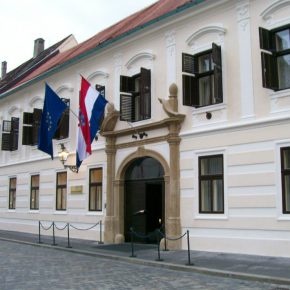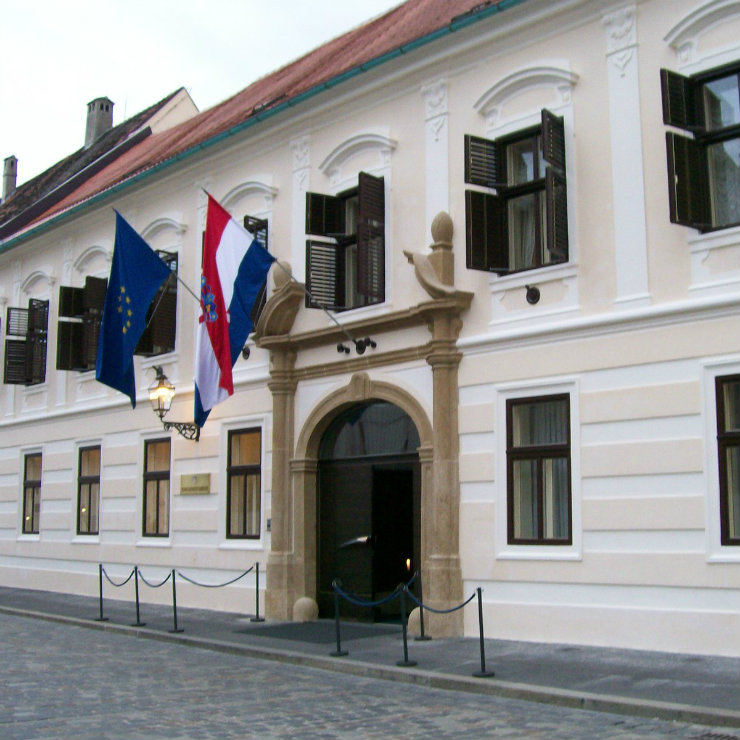
Croatian government building, Zagreb (Suradnik13, CC BY-SA 3.0)
The National Reform Program is adopted each year and defines economic policies and measures for the implementation of the Europe 2020 Strategy. The Convergence Program is a wider document that encompasses most of the government’s policies and reforms, and focuses on the macroeconomic framework of the fiscal policy. Both documents are being submitted within the framework of the European semester — the cycle of co-ordination of the economic policies of the member states of the European Union.
The National Convergence Program 2019-2022
The Macroeconomic Framework is defined with a growth expected to continue at a rate of 2.3-2.5 per cent a year, with a dominant impact on personal consumption, which will fall by 2022, with export return being the strongest growth factor. Investment growth is planned at relatively modest rates that slow down to 4 per cent per year at the end of the forecast period. The question is how much of it is in line with the possibilities of using EU funds, which promise higher growth rates (because a large part of EU funds affects investment). Namely, the Program states that about 19 per cent (EUR2bn) of the total allocation of European Structural and Investment Funds (ESIF) for the budgetary period till 2020 (and even up to 2023) has been withdrawn so far, while contracted about 67 per cent (EUR6.8bn), which means that up till now Croatia has almost EUR5bn of possible funds to attract. The EU funds have an impact on the GDP growth.
The above assessment does not include the effect of EU funds to total productivity. This effect is always doubtful, but the government shows projections of total productivity growth in the Convergence Program. A smaller contribution will come from direct investment of capital and labor factor, and greater than their combined productivity. Croatia is notoriously weak in increasing productivity. Relatively conservative growth projections from the document reflect the hidden fear of further economic slowdown in the EU in the second half of this year and next year. But, maybe more important could be the other cause, since the arrival of Zdravko Marić in the Ministry of Finance, growth is forecasted conservatively, as not to exacerbate the hopes and ambitions of budget users. Those more ambitious projections would quickly move to the overwhelming demands on state spending the government is trying to avoid, as the goal is to bring highly-indebted Croatia into a moderately indebted country to expand the long-term fiscal capacity.
After the general government budgetary surplus in 2017 and 2018, a slight sliding in the deficit zone in 2019 is expected, and then the return of surpluses from 2020 to 2022. The economic growth and the general government balance are expected to continue with the trend of falling ratio of public debt and GDP at 62 per cent in 2022. It should be stressed that the requirement for the introduction of the EUR is not to achieve a ratio from Maastricht (60 per cent), but to reduce the ratio by about 1 percentage point per year, which is more than projected in the Program.
These frameworks and goals will face several challenges. The biggest challenge is the parliamentary election next year. It is difficult to maintain fiscal discipline in the election years. The share of general government revenues and expenditures is expected to decrease, but the question whether politicians are prepared for such discipline. In addition, the figures show that no significant further relaxation should be expected beyond the already announced (and adopted) reduction in the general VAT rate from 25 to 24 per cent, although the piece of the general government sector ranges from 45 per cent to 46 per cent, which can only be afforded by highly developed countries. Small-scale compromises with the correct direction and use of a positive business cycle are typical for the current government, which will obviously continue until the end of its mandate. This is positive, but not good enough, because Croatia needs a stronger boost to accelerate growth. It could come from structural reforms, and for this the National Reform Program is made.
The National Reform Program
Three main goals, ten priority areas, 30 measures, 100 activities: this is the summary of the National Reform Program 2019. The government stresses that the planned reforms are aimed at „ensuring a reliable business environment and creating conditions for encouraging investment in the Republic of Croatia, ensuring the sustainability of public finances and implementing structural reforms that will enable further growth of the economy”. The three main goals are:
- strengthening the competitiveness of the economy;
- linking education to the labor market;
- sustainability of public finances.
The report on the implementation of the reforms refers to the „Measures taken to ease the business in 2018 and the first quarter of 2019” related to the Doing Business methodology of the World Bank. Regulatory reforms were carried out in the area of registration of ownership, payment of taxes and obtaining building permits. At the same time, it announces the electronic start-up of the business through the START system, as well as simplifying and reducing the cost of leaving the market for liquidation without bankruptcy. The government has hopes of making progress on the Doing Business List. However, it has been forgotten that the functioning of the credit registry has an impact on ranking.
The government will also set up a Productivity Committee. It would not be a classic state body, but an independent body for analyzing, designing and implementing policies that are essential for increasing productivity and competitiveness. Such an initiative is in line with the Council of Europe Recommendation from September 2016. This committee could be a central place for planning and encouraging the implementation of structural reforms that will be more important in the context of the introduction of the EUR. Also, the independence of the board and its composition, which would involve representatives of various stakeholders, could be an added value. However, for already 15 years Croatia has had the National Competitiveness Council set up in the similar manner. In the past the Council has made a number of useful recommendations that have not had any impact on politics.
Education is a key area. Most research shows that this is a critical growth factor in the long-term perspective. The advanced economies pay great attention to their education systems. Significant changes has been introduced for two years. After the pilot reform year (in 48 primary and 26 high schools), comprehensive education reform will be introduced in all schools in autumn 2019. The government document says that the goal is to adapt education to the labor market; the digital transformation of schools has been implemented, and dual vocational education has been introduced, with emphasis on practical teaching and development of regional competence centers.
Vedran Obućina is an analyst and a journalist specializing in the Croatian and Middle East domestic and foreign affairs. He is the Secretary of the Society for Mediterranean Studies at the University of Rijeka and a Foreign Affairs Analyst at The Atlantic Post.


